|
FAQs about the Striped Sailfin Tangs,
Zebrasoma desjardinii, Z. veliferum:
Disease
Related Articles: Striped Zebrasoma Tangs, the Genus Zebrasoma,
Related FAQs: Striped Sailfin Tangs 1, Striped Sailfin Tangs 2, & FAQs
on: Striped Sailfin Tangs
Identification, Striped
Sailfin Tangs Behavior, Striped Sailfin Tangs
Compatibility, Striped
Sailfin Tangs Selection, Striped Sailfin Tangs Systems,
Striped Sailfin Tangs
Feeding, Striped Sailfin
Tangs Reproduction, & Zebrasomas I, Yellow
Tangs, Purple Tangs,
Surgeons In General, Selection, Tang Behavior, Compatibility, Systems, Feeding, Disease,
|
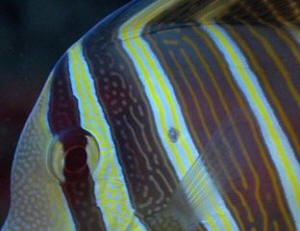
|
Surgeonfishes: Tangs for Marine Aquariums
Diversity, Selection & Care
New eBook on Amazon: Available here
New Print Book on Create Space: Available
here
by Robert (Bob) Fenner |
 |
Patches on Sailfin tang; and now missing fish
mysteriously 5/1/19
Hi team,
<Bodh>
Many thanks for the advise you had provided me earlier on my Sailfin
tang that had patches. Waiting for couple of days really worked. All
patches disappeared. Thanks again.
<Ah, good>
I am faced with a new problem of fish disappearance. I lost one Powder
tang, Smoke angel, copper band, one damsel and one neon damsel in just
last 25 days. All just vanished next morning . I could see some remains
only. The green carpet anemone was removed and shifted to refugium when
I lost copper band assuming that it might be the eating culprit. But
disappearance continues.
<Mmm; disconcerting for sure>
I have currently the following in the tank
1. 1 Yellow tang 2.4 inch
2. 1 Purple tang 2.5 inch
3. 1 Sailfin tang 3.5 inch
4. 1 Regal tang 1.25 inch
5. 1 Blue damsels small (1 inch)
6. 1 Fox face 2.5 inch
7. 1 Pink Anthias small (1.5 inch)
8. 1 Banana wrasse 2 inch
9. 1 Camel shrimp
10. 3 hermit crabs small (1-1.6 inch)
11. 1 Percula Clown 1.25 inch
12. 1 Sebae clown 1.75 inch
<None of these likely perp.s>
Tank size 4 ft x 2 ft x 2ft. Water parameters are all ok . Ammonia 0 ,
Nitrite 0 , Nitrate 2 ppm
When restarting wave maker after feeding , I sometimes notice
transparent membranes floating in the tank
I am really concerned about my fishes vanishing.
What can be the possible reason please. Or where am I wrong.
Please help
Thanks & Regards,
<The usual suspects to mention... Large (and many)
polychaete/bristle-worms; crabs, mantis... I'd be trying putting out a
baited trap or two towards lights-out time to see what you might catch.
Search on WWM re trap designs. Bob Fenner>
Re: Patches on Sailfin tang 5/1/19
Thank you very much Bob. Can u please send me the link on WWM re trap
designs to make a trap. I was looking for the same on WWM but I am not
lucky.
<http://www.wetwebmedia.com/results.html?cx=partner-pub-4522959445250520%3Ap7g47g81naq&cof=FORID%3A10&ie=ISO-8859-1&q=trapping+hitchhikers&sa=Search&siteurl=wetwebmedia.com%2F&ref=&ss=5416j2111552j20
>
Thanks & Regards,
Bodh Raj
Re: Patches on Sailfin tang 7/28/19
Hi,
Many thanks for time to time advise you have been providing all as part
of the big "Marine Life" lovers community.
This is only a thanks message for your timely advises you have been
providing to me.
धन्यवाद,
सादर,
<Certainly welcome. Bob Fenner>
Desjardini tang in decline
6/14/19
Dear Crew,
<Hi Simon>
I've tried searching through the answers on Tangs but can't find anything that
fits exactly what I'm seeing.
I have 2 inch Desjardini Sailfin Tang who's been in my 80 gallon tank for about
a month and a half.
<Will need bigger quarters in time, Tangs need plenty of space to thrive.>
He's normally very active scooping up all food before my fuzzy lionfish can get
anywhere near it. My other livestock are a 2.5 inch red fire shrimp, two conchs
and a few turbo snails.
Everyone gets on fine so there's no stress there.
Last night the normally very active tang stopped swimming around and started
swaying on the tank floor in a cave near the fire shrimp (maybe looking for but
not getting a service).
He spent most of the night swaying side to side on the floor and then moved to
another corner of the tank where he swayed back and forth rather than side to
side. He seems to just sit on the gravel and is very lethargic and
not eating at all vs. the previous voracious appetite.
<How are your water parameters?...numbers.>
He came to the front of the tank still hugging the gravel bed and I couldn't see
any visible signs of parasites or disease.
<Not always visible and less in the early stages of a disease>
I'm not sure if I imagined this but it seemed like the area around his stomach
looked darker (under the skin).
<Could be something environmental... water quality, oxygenation, etc.)>
I put a bottom feeder shrimp tablet in to see if that could encourage him to eat
and eventually he bumped into it, more hit it a few times with his nose to
spread it around but didn't seem to actually eat it. I've also tried putting
some nori in the tank to see if that could encourage him to eat and tried garlic
soaked brine shrimp but nothing
enticing him to eat at the moment as he's not leaving the bottom of the tank.
The tank is 10 yrs old but I've only had it for 6 months so it pretty much
cycled again, I usually do a 20% water change every 2 weeks although I was
behind this time as the LFS water supply was out when I went to collect.
I urgently did the water change today but no recovery from the tang, having read
around I'm quite worried that he may not last, any advice on any course of
action to take would be greatly appreciated.
<If you already performed a water change, I suggest leaving it without trying to
feed it and see if it shows any signs of improvement in the next hours.>
Thanks, Simon
<Cheers. Wil.>
Re: Desjardini tang in decline
6/16/19
Hi Wil,
<Hi Simon>
Thanks for the quick response,
<Not so quick now, ha-ha...sorry for the delay, was out of town >
looking at the water test results I think I need to still do another
water change, nitrates at 10ppm, phosphates at 0.5 ppm.
I did see him swim mid water briefly yesterday when the lights were part
off (blue only), I'd say he seems a bit more active but not much.
<Dim lights help in reducing stress>
Will do another 20% water change and see if he picks up.
<Good>
It did occur to me that I had a feather duster that lost his quill and
recently left his casing, I thought he was still recovering but could be
that he passed and could have caused a spike in the water parameters.
<Possibly>
Keeping my fingers crossed he recovers with better water, any other
advice greatly appreciated.
<Water changes are always beneficial; I think you’ll see an improvement
in your tang.>
Thanks,
Simon
<Welcome. Wil.>
Sailfin Tang Heavy Breathing
12/23/18
Hi crew,
<Hi Charles>
I have trouble in my aquatic paradise, so please bear with me as I provide
background:
I have a 75 gallon mixed reef (100 gallons total system) with
the following livestock:
2 ocellaris clowns
Desjardin tang (I know will need larger system in the future)
Tailspot blenny
And until recently:
Helfrichi Firefish
Potter’s Angel
In the last few days I lost the Potter’s Angel - saw its shadow under a rock
breathing very heavily. By the time I could get to it, he was dead. No outside
signs of ich or other infection. Had been behaving normally up until at least
the day before.
A couple of days later, I haven’t seen the Firefish (he normally only comes out
to eat) and the desjardinii tang is breathing heavily, just hanging out in one
spot (he usually cruises around the tank), and not eating - ignored the nori
that I put in and seems only passingly interested in other foods.
Normally he eats like a pig.
The clowns and blenny show no apparent symptoms.
<Something amiss here, likely a chemical issue>
Last addition to the tank was a skunk cleaner shrimp 2-3 weeks ago (which didn’t
survive for more than a couple of days, unsure the cause of loss) with some
snails and emerald crabs and a pistol shrimp in the attached 30 gallon mangrove
tank, and the Potter’s Angel a couple of months ago (following 6 week
quarantine).
Water parameters:
SG 1.025
Ammonia 0
Nitrates 0
pH 8.0 <A bit low>
Most things have been fairly stable in the tank. My corals (a mix of lps and
softies are ok, but have some slow necrosis on the lps). The only recent change
I can think of is the introduction of the ill-fated cleaner
shrimp, though I hadn’t been concerned about it bringing in disease...
Right now, the tang and clowns are in my 20 long quarantine tank. The blenny I
will try to catch tomorrow. I was planning to dose them with Cupramine (have the
appropriate test kit), but wanted to see if you had any additional thoughts or
advice on likely diagnoses or treatments.
<You didn´t mention your tank equipment. Chemical/Biological filtration,
maintenance practices, etc…If it were me/my fish, I would not medicate them,
unless I was sure of the symptoms to be treated. Do you use activated carbon
regularly? It may be something toxic in the water that test kits don´t show;
probably fumes or other toxic chemicals used near the tank. >
Thanks,
-Charles
<You´re welcome. Wil >
Re: Sailfin Tang Heavy Breathing 12/27/18
Hi Wil,
<Hi again, Charles>
Thanks for the input.
<Glad to help!>
I have a small refugium with Chaeto in my 20 tall sump with an rtss skimmer
(think it’s rated for 120gallon or more, don’t recall).
<Do you mean ETSS?>
I usually empty it once a week. I also run gfo in a reactor and a 36watt uv
sterilizer. Yes, pH is a bit low, but has been fairly stable. I’ll chase that
next. What you say regarding some chemical poisoning makes sense. I had to
travel today, but this morning the tang looked much better, not breathing
heavily in the quarantine tank. I’ll see if he eats later. I did drop some
Polyfilter into my sump before leaving this morning.
<A very reliable and effective product>
Hopefully the blenny is well. Will put some carbon in next. Will hold off on
medicating if the fish in quarantine do well.
<Good idea, please let us know how everything goes.>
Thanks again.
-Charles
<Kind regards and thanks for sharing. Wil.>
Re: Sailfin Tang Heavy Breathing 12/27/18
Hi Wil, Merry Christmas!
<For you and yours too, Charles!>
I meant RLSS skimmer, too many abbreviations to remember...
< Ahhh… haven't try this units myself but have heard good comments about them.>
The refugium runs on a reverse daylight cycle to the display tank. Well, so far,
everyone in quarantine is happy. Tang is back to eating like a pig, just a bit
miffed at being downgraded to the economy suite.
<Hopefully it returns soon to the display tank, Tangs need plenty of swimming
space and highly oxygenated water.>
The blenny has survived, so far. He came out to eat today. No sign of rapid
breathing on his part.
<Good to hear>
I’m 99% sure the Firefish is dead. I replaced my gfo with a mix of gfo and
carbon (since I don’t have another media reactor) on Christmas Eve. No idea
whether or not it’s helping, but since the blenny is still doing well, can’t be
hurting anything. I tested everything I could this morning, and the parameters
are: SG: 1.025 pH: 8.0 (still low, but consistent)
<Try using a marine buffer>
Ammonia: 0 Nitrite: 0 Nitrate: 0 (maybe this is why my coral is unhappy)
<Could be>
KH: 9 Calcium: 464 Magnesium: 1320 I couldn’t check phosphate since I just found
my kit expired. I haven’t been able to point to anything that would poison my
fish, especially since my pincushion urchins and maxima clam are happy. Perhaps
something that specifically targets gill function or dissolved oxygen (I feel
like this would be odd, since the skimmer is doing a pretty good job on the O2
front)?
<Do you have enough water movement, surface agitation?>
I don’t think it’s anything in my source water for top-off, since I used that
same water to set up the quarantine tank (RO/DI into 5 gallon bucket, then
pumped into sump for top-off or into other container for use). I did just
increase the max light intensity by 5%, to see if that mad my corals any
happier. Could this have irritated someone enough to cause them to release
something nasty?
<I don´t think that´s the case here, no.>
Coral list is: Assorted Zoanthids Two different types of button polyps Three
different Sacrophytons A toadstool leather Various mushrooms (grow like weeds
usually) A Hollywood Stunner chalice Red chalice Tyree ocelina (sp?) Two Galaxea
colonies Red Acan Goniopora (has been slowly wasting away)
<Ah yes, Gonioporas are hard to keep in good health>
Yellow polyps Cat’s paw I ordered an ATI ICP test kit. Maybe that will pick up
something that is causing problems. As I wait for the results, I’ll try to
figure out what to do about getting my nitrates up a little bit.
Another long battle, since my mangrove tank looks like a swamp due to all the
hair algae.... Thanks again for the advice. I’ll send an update when I get water
test results and/or if I gain any additional information. Any additional
suggestions?
<I advise you to trim the algae in your refugium, this way you will let nitrates
rise a bit.>
I hope the whole crew is enjoying the holidays. I appreciate all the advice!
Best, -Charles
<Enjoy the holidays too, Charles! Greetings. Wil>
Re: Sailfin Tang Heavy Breathing, I2 poisoning
2/17/19
Hi Crew,
<Charles>
A much delayed update on this situation:
So I sent out my water for an ATI ICP-OES test. It came back mostly good, with
one huge and one marginal out of balance parameter:
Iodine was just under 40,000 micrograms per liter, nearly 1000 times what it
should be!!!!!
<?! Where did this I2 come from?>
Salinity was low - 29.76 PSU. I'm not sure this was a good measurement - I
ordered pinpoint calibration solution, recalibrated my refractometer, and was
still getting an SG of 1.025. Not sure why the large discrepancy.
<Mmm; well... specific gravity is NOT the same as salinity... i.e., you could
have other dissolved solids that are raising the former that are not salts.>
I think it's safe to say the iodine concentration was the cause of death of my
fish, as well as the decline of so many corals. I had been dosing iodine,
without testing.... bad reef-keeper.
<Aye yi yi... What is my mantra here? "Never dose/add something you can't and
don't measure".>
I had been dosing iodine for nearly a decade, in the same manner (automatic
doser for the last couple of
years) without testing and without noticeable issues - I had been under the
impression that iodine dosing was critical for crustaceans building their
exoskeleton.
<Well; yes; but very little. Many, likely most folks get by with the little that
comes in w/ new synthetic water changes, foods>
In the fall, I switched brands to the two little fishies iodine concentrate and
adjusted my dosing accordingly (I don't recall which I was dosing before, may
have been Kent). I'm not sure if something weird happened at that time, or it
was just accumulating over a very long time.
Regardless, after more reading about iodine and the mixed information on the
need to dose for a healthy reef, I've decided to discontinue dosing iodine
altogether.
<Okay>
Now, to remedy the iodine issue, I started doing several large (30%) water
changes over the course of a couple of weeks. My corals started to respond
within a few days of the first water change. Still not doing great, but starting
on the road to recovery. I had also gone out and bought a Red Sea iodine test
kit. My first test was, of course, completely off the scale of the test kit,
which only goes up to 0.09 ppm. I wasn't surprised, really, when after 4 or 5
water changes, my readings were still off the chart, since the starting
concentration was so high. At this point, I sat back and considered the fact
that it would take months of water changes to get the iodine under control. I
finally decided to just do a 100% water change. No fish in the system, and all
the other parameters were within reason, so
nothing to lose with replacing it all.
<Mmm; you might add a "pad" of PolyFilter or a bag of ChemiPure in your filter
flow path. These will absorb the leaching/back I2 over time.>
Finally, after the 100% water change (my dining room was filled with buckets and
bins, and I learned my total system volume is actually about 75 gallons....), I
checked my iodine levels and.... still off the chart.
<Ah yes... see above>
Something seemed strange with how the test kit was functioning, since the
reaction is supposed to take 10-15 minutes, but seemed to complete
instantaneously. Lo and behold..... my reagents had expired 1 month BEFORE I
bought the test kit. I wasn't pleased. I did send a note to the LFS to let them
know of this issue. I expect they don't sell many of these test kits, and a
couple of forum posts indicated the Red Sea iodine reagents expire very quickly.
I decided that, since I had just replaced all (except for a couple of gallons in
plumbing, etc) of my water, there was no way the iodine was at lethal levels. My
coral had already started to really respond and open up, regain color etc. So I
moved my two survivors (the clown and sailfin - who had survived a bout of
"black ich" in quarantine - thanks general cure) back into the main display.
They are now happily swimming around, and the sailfin is starting to mow down an
infestation of grape caulerpa that has taken over since his eviction.
<Some good news>
It looks like I'm finally back on track. I'll likely never dose iodine again -
just not worth the trouble. Certainly won't dose without testing again.
<Yay>
Once I go a week with everyone still happy, I'll set up the quarantine tank
again and begin to repopulate the tank - it just looks so lonely with 2 fish in
there.
Thanks for all your advice. Hopefully any future emails will be with happier
questions - like which dwarf angel I should put in there (leaning towards flame
or coral beauty, since I'll be moving in the next couple of years and don't want
to put a potter's through that stress).
Regards,
-Charles
<Thank you for your report. You've likely helped MANY other people to come.
Bob Fenner>
Purple Tang - Ich - Cupramine
6/9/16
I have a dilemma and would appreciate your great advice as always.
<What's up?>
Note that I have a permanent running and fully established 75 gallon
QT/Hospital tank.
<Good>
About 4 weeks ago I purchased a Purple Tang (maybe 5 inches in size).
<What did Gurley Halleck expound when seeing his first worm in "Dune"?
"Egads, what a monster"! This is a big Zebrasoma to purchase, collect
from the wild>
I purchased it from a reputable LFS. It was eating like a pig, was
active, and showed no signs of illness. They stated that it had been in
their possession for a few weeks.
<I see>
As I do all new fish arrivals, I put it into my QT/Hospital tank for
close to two weeks.
<Mmm; no dip/bath enroute? I would do so... to "knock off" Protozoans,
Trematodes... external issues>
It was fine, eating like a pig, no issues, no illness. Thus, I moved it
to my 150 gallon DT. This tank has been disease free and all the
readings are very good. I believe in "over-filtration", thus there's
plenty of flow, a UV filter, oversized skimmer, oversized sump pump,
refugium (with Macroalgae, red mangroves..), and about 100+ pounds of
live rock...etc. I have high powered LED's on the tank. There's been no
issues of aggression within the tank and the Purple Tang would be
hypothetically considered the most aggressive type of fish in that tank
and the currently largest fish
for that tank, excluding a well fed 10 inch Snowflake Eel that minds his
own business and who's been a good citizen.
<Echidna spp. usually are>
Other inhabitants are a 3 inch Flame Angel, a 3 inch Koran Angel, a 4
inch Majestic Rabbitfish, and a 3 inch Sailfin Tang.
<Okay>
I knew that I was "rolling the dice" with the Sailfin Tang already being
in there, but after a lot of reading and visiting with LFS' I was fairly
confident it would work as I've previously introduced a Sailfin Tang
into a different 150 gallon tank with an established Yellow Tang that
has worked out well thus far and for over a year. IMO, from research and
experience, it seems like the Sailfin Tang's are more likely to co-exist
of the Zebra species if introduced at a different time.
<This is my and many others (recorded) experience as well>
After a little bit of posturing back and forth maybe for 2 days, the
Purple Tang and the Sailfin Tang adjusted and accepted each other. I
never witnessed any chasing or nipping, simply a bit of posturing,
flaring up of the fins. The Purple Tang continues to eat well. However,
within the last week the Purple Tang has developed Ich. None of
the other fish display any signs of Ich.
<Common and not uncommon>
The Purple Tang continues to eat like a pig, swims all over the place,
and seems very healthy, very happy, except for the Ich, always very
eager to eat, getting excited when I approach the tank. I feed him and
the tank a mix of mysis shrimp, brine/Spirulina, and algae sheets.
Since he developed Ich I've been adding Socol, VitaChem, and Metroplex
mixed with Garlic into the food this tank eats. All of the fish eagerly
eat at each feeding which is 3 to 4x a day. Usually I feed 2x a day, but
I stepped up feedings to hopefully strengthen their immune systems.
Here's my dilemma, I could move the Purple Tang to my QT/Hospital tank,
which seems like a no brainer, and for most any other fish I would do it
ASAP, but this Purple Tang, despite its case of Ich is a very happy fish
that's very active and eats like a pig. I am concerned about stressing
it out, trying to catch it, then move it to a new tank. Might this put
it
into a downward spiral?
<It could; yes>
I've always successfully used 1/2 the recommended dosage of Cupramine to
treat Ich. Keeping the fish in QT for 4 weeks. I just ordered some
Dr.G's Caviar that includes CP too that I intend to feed this 150 gallon
DT with the Purple Tang. I've done some research on Purple Tang's and
Cupramine and it appears that they might have more sensitivity than most
other fish to Cupramine?
<Tangs and allies... and a few other fish families/groups too... You can
search, read this on WWM, in books I've penned>
Thus, this too, makes me think I should continue to treat the DT with
medicated food. However, am I doing the right thing? Would you move the
Purple Tang to the QT? Thank you.
<I would NOT move the Tang... but leave in place, continue w/
the feeding treatments you're doing and have planned. Some
archived input on the subject here:
http://www.wetwebmedia.com/parasittksfaqs.htm
and the linked files above. Bob Fenner>
Fw: Purple Tang - Ich - Cupramine
6/9/16
I forgot to mention that this 150 gallon DT with the Purple Tang is a
reef tank, thus my use of treatment so far by medicated food.
<Ahh; please read here as well:
http://www.wetwebmedia.com/reefparasittksfaqs.htm
and the linked.... B>
Re: Purple Tang - Ich - Cupramine 6/10/16
Thanks Bob. I very much appreciate your expertise. I really needed
someone of your caliber of experience to review my dilemma and give
their opinion.
<Glad to share, render it>
My gut has been to keep the Purple Tang in the DT considering it behaves
very healthy, eats like a pig, seems really well adjusted, except for
the Ich, but I've been torn, knowing that I have an established QT.
Thanks again!
<Welcome>
BTW, note that on my QT/Hospital tank, for all new arrivals, unless I am
aware of any sensitivity to Cupramine, I dose the QT tank with 1/4 to
1/2 the recommended dosage of Cupramine for two weeks as my method to
treat for any diseases before introducing them into the DT.
<Mmm; well; the standard spiel re treatments, moda am sure you're
familiar w/; and Cu++ exposure period... does more harm than good
beneath some threshold "physiological" dose... likely near/below 0.15
ppm you're poisoning the fish hosts more than accomplishing any positive
effects>
This strategy has worked really well for me on new introductions thus
far except for this Purple Tang. I have ParaGuard, PraziPro, and Ich
Attack available in my arsenal to use too that I had tried in my earlier
reef/fish
keeping days for new arrivals, however, from experience, I've had by far
the most success with Cupramine at a reduced dosage thus I've stuck with
it for new arrivals. Beyond this, my strategy for any new coral arrivals
is to use ReefDip for 30 minutes.
<Ah, good. I've used and caused to purchase hundreds of carboys of
Cupramine. Am a fan as well. Cheers, BobF>
Re: Purple Tang - Ich - Cupramine 6/10/16
A worthy summation re Cu use in aquatics:
http://edis.ifas.ufl.edu/fa165
B
Re: Purple Tang - Ich - Cupramine
6/11/16
Bob-
I thought I would report back to you the status of my Purple Tang based
upon our mutually agreed decision to keep him in the DT vs. stressing
him out and moving him out of the DT. I am very pleased to report that
after about a week of the medicated food treatment I described below,
around 90% of the Ich spots are gone and he now has just a few spots,
while none of the other fish have displayed any Ich.
<Ah, good>
I believe our strategy of keeping him in the DT with the
medicated food cocktail with extra feedings has made a difference.
<Yes; a matter of balance. Shades of John Venn! Have you recently read
this?:
http://www.wetwebmedia.com/fwsubwebindex/fwdis3setsfactors.htm
If he had shown any signs of being passive, hiding, or as you've said in
past posts to others, i.e.; a party in the corner with himself I
believe, I would have definitely moved him to the QT and administered
Cupramine.
However, despite the Ich, as he was very active swimming, looked strong,
was eating like a pig, not hiding at all, the decision to keep him in
the DT with this treatment method appears to be working well. Quite
pleased.........
<Again; the reading... and understanding. Most all systems are
subclinically infested... READ. B>
|
Desjardini Tang with black spots
6/20/15
Hello there,
<Gary>
I had this tang for about 3 weeks now. I had quarantined him for 14 days
then moved him into a holding tank for 7 days before introducing him to the main
system.
<I see>
He's developed this dark black spots overnight and I'm not sure what they are. I
read on your site that it could be stress marks? It doesn't look like
black ich. Do you think that's its just stress?
<I do think this is as you state; not pathogenic, like Trematodes... Good care
and time going by will see these spots go.
Bob Fenner>
|
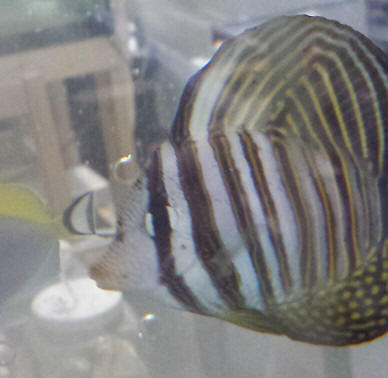
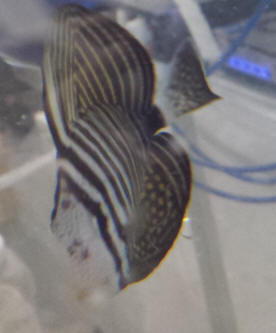
|
Re: Desjardini Tang with black spots; plus now Premnas "rash"
6/25/15
Hello Bob,
<Gary>
You were right the spots disappeared within 2 days.
<Ahh!>
Thank you for your help. I have a pair of Clownfishes and the female appears to
have a lesion on its bottom side. I've quarantined the pair in a separate tank
already.
The lesion was getting better the other week, but today I noticed that it got
bigger. Do you think it's Brooklynella?
<No>
If so I have some Ich-X formalin ready. Better to get it a long bath or add it
into the quarantine?
<I would not dip or treat this fish... yet. This "rash" may be "natural"; an
endocrinological manifestation. Bob Fenner>
Re: Desjardini Tang with black spots 6/25/15
Ok thank you. I will refrain from doing anything further. Anything that you
would recommend to help it recover?
<The usual: Optimized, stable environment and good nutrition! BobF!>
|
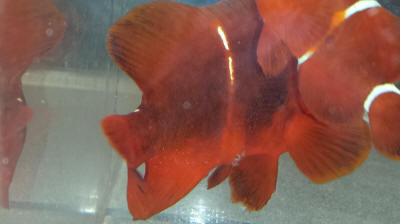 |
|
|
Sailfin tang... 8 megs.... NNS
4/18/15
Hi I jabe a quick question my tang came with this tank so he's old but I have
noticed this black spot at his mouth area that I can't seen to remeber him ever
having. It's a single spot no other fish have a spot similar to it. I have
include a picture to help. Trying to figure out if he needs any thing
medically speaking or if I should be worried about him or the other fish in my
tank.
<Nothing medically to apply here. Likely this melanistic area is due to a
long-since trauma.
Bob Fenner>
|
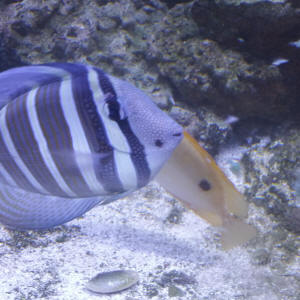 |
|
Sailfin tang - discolouration 4/6/13
Hi everyone,
<Marc>
Thanks as always for your help with these questions. I have a Sailfin
tang that I have had in QT for the past 3 months
<... what?>
with a Tomini Tang. Both were purchased with no signs of disease and were
in good shape with no signs of malnutrition and good colour. I had them
in QT for 4 weeks and then put them through a proactive 4 week hypo at
1.009. I then brought them out over one week. During this time
they ate and showed no signs of distress.
<... these markings are>
I have planned to put them into my main tank but noticed white patches
on one side of the sailfin tang that appear on closer inspection to be
discolouration in the skin. There are no signs of raised spots or any
parasites. The Tomini shows no signs of any discolouration. They are
still eating and looking healthy otherwise.
I was just keen to find out what may have caused it.
Cheers
Marc
<Perhaps an altercation w/ the other fish; perhaps latent stress. I
would these fishes into the main/display, not treat the system w/
"med.s". Bob Fenner>
|
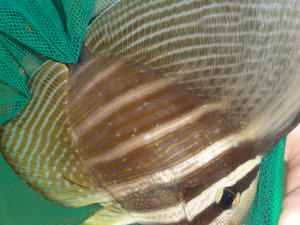 |
|
Black Ich / Paravortex or something else? Picture #2
3/29/13
Here is another picture of the sailfin tang with possible black Ich.
Thank you for your advice.
Wendy
165 gallon reef
Orphek LEDs
AquaC ev 240 skimmer
30 gallon sump
15% water changes done weekly
live sand
150 + pounds live rock
normal water parameters
78 degree temp
1.025 salinity
varied diet (variety of dried seaweed, multiple kinds of frozen foods,
pellets, flakes, live foods, macroalgae)
refugium coming in May
<Not black Ich, Paravortex. These melanistic markings are common in many
tangs... blemishes from mechanical injuries... bumping into objects in
the tank. Not problematical. Bob Fenner>
Black Ich / Paravortex or something else?
3/30/13
Good Evening WWM crew,
This is a picture of my Zebrasoma desjardinii. I noticed these
brown/grey/black spots (or "splinter looking shapes in some
areas") on the fish when its coloration shifted lighter this morning
(normally dark, but shifts to light when I do water changes or annoyed).
Anyhow, I started searching for what it could be and I am afraid it is
black Ich. Can you verify by the photo? I can send you
another photo, too.
<My estimation is the same>
I understand that a fresh water dip needs to take place.
<Nah>
One time and put the fish in QT or one time and put the fish back in
display?
<I wouldn't touch this fish. Leave it where it is>
Do I need to fresh water dip all fish, no other fish have spots that I can
see.
Please advise on what to do if my entire 165 gallon reef tank is
infested with Paravortex? The thought of breaking down 150 pounds
of live rock (not to mention disturbing lps and sps) to catch a breeding
pair of Banggai, clown pair, PJ cardinal pair, pearly Jawfish pair, an
ornate leopard wrasse, a juvenile orange line bristle tooth and the 6"
sail fin is daunting. But I will do whatever it takes to get
things back on track.
Do you suggested I remove all fish and let the tank set empty of fish
for 8 weeks? Can I leave in the peppermint shrimp, skunk shrimp,
emerald crab and snails?
Thank you,
Wendy
<Not to worry. BobF>
|
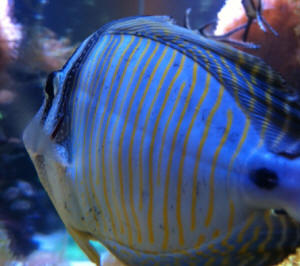
 |
sailfin spots on fin 7/12/12
Hello Bob and crew,
I recently purchased a small/medium sized Desjardini Sailfin tang (~5").
He was fine for a couple of weeks but soon started to show a white spot
on his right pectoral fin. It was about the shape and size of a grain of
rice, perhaps a little smaller. Over the course of a few weeks this
large spot stayed, but many smaller spots started to form on the same
fin, some close to the original spot and some far. He now has about 6
spots but the only big one is the original - the rest are tiny like
grains of sugar. It has been almost 2 months since addition of the fish
and there are still no spots anywhere else on his body. Any ideas what
this may be, and what I can do to treat it?
<Can't be certain w/o sampling and microscopic view, but this reads like
a trematode infestation. Read here:
http://www.wetwebmedia.com/fshwrmdisflukef.htm
and the linked files above. Bob Fenner>
Thanks for all your help and the great site.
Paravortex on a sailfin tang 6/25/12
I have a desjardinii tang which is about 14 inches long, he is in my sps
aquarium which is kept at 11 DKH and 420-450 calcium ideally. The
temperature is 78-80 degrees consistently. I rescued this fish from a
tank full of tangs (mostly yellow) that had Paravortex, and he had not
eaten for a week. When I removed him from the previous tank I gave him a
8 minute freshwater dip in hopes to kill the Turbellarian.
<Usually does it. I'd add a bit of formalin (and aeration) on the next
go>
A few days after being in my system he began to eat. I have had him for
2 months now and he was doing great until I upgraded a week ago to a
bigger aquarium. He did break out with some Ich which I expected, but he
also has a slight haze over his eyes. He is also eating, but not with
the voraciousness he once did. I sometimes can see small black lines on
him which are around 1/4" long. My problem is that since he is dark in
coloration I cannot conclude whether he has black Ich or not. I do not
want to lose such a nice fish, but quarantine and treatment will be
difficult on such a large fish.
<Just the dip/bath>
I know the best treatment is Praziquantel. I would assume that an 8 minute
dip would kill the worms, but at the same time cannot explain the black
lines
<"Just stress">
which seem larger than black Ich in my experience. Any advice would be
greatly appreciated.
Thank You,
Terry Baldwin
<Better to move the fish to a clean setting after the bath:
http://www.wetwebmedia.com/dips_baths.htm
and the linked files above. Bob Fenner>
|
Sailfin tang not eating splotchy looking what can this be
5/30/12
<... water quality and/or nutrition... See WWM re Zebrasoma hlth., nutr.
Bob Fenner>
|
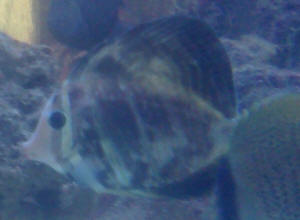 |
|
Desjardinii Sailfin Tang with Possible
Ailment 6/4/11
Hey Crew,
<John>
I added a Desjardinii Sailfin to my 300g reef about 3 weeks ago
after 3 weeks of QT. The fish was active, eating, and by all
visible signs healthy when I introduced him to my display, and at
a glance the same appears to be true today. However, on close
inspection, I can see white "markings" on the body of
the fish. (See pic).
<I see these>
It does not look like Ich or velvet, and the marks are not raised
above the skin. It looks like random scratches that turned white,
and at first appearance that's what I thought they were. But
then more appeared, and it just doesn't seem like that is the
case anymore.
I also noticed that the fish is respirating a little faster than
normal, sometimes. Not the fastest I've ever seen from a sick
fish, but faster than all of my other fish. I chalked this up to
nerves at first, but again, I'm not sure about this
either.
<Is "nerves"... in a word,
"stress">
The fish is very social, active, hungry fish otherwise. I feed
everything from formula 1 and 2 flakes, to mysis shrimp, a good
pellet, prime reef (frozen and flake), Cyclop peeze, ArctiPods,
Nori, and he consumes it all, with garlic and Selcon added each
feeding. For these reasons, I'm also pretty sure it's not
nutritional.
<Agreed>
My tank's levels are as follows. Ammonia 0, Nitrite 0,
Nitrate about 0 .
<How kept thus? Some chemical filtrants are too toxic to types
of aquatic life>
Temperature is stable 79 degrees, 4 inch DSB in display and in
refugium, 350 lbs live rock, 40 gal sump, 40 gal fuge, 4x400 MH,
2 VHO actinic, plenty of circulation. I have 4 tangs, all of
different genus,
<Genera, and this is likely the primary source of stress
here... But, w/ time going by, this fish will very likely
blend/mix in, lose the stress markings>
and they all get along together very well. I have a magnificent
Foxface, 3 clowns, a mandarin, and a few Chromis as well. Plenty
of cleaner shrimp in there too.
Stinging from a coral also seems unlikely, just because the marks
are on both sides of the body and pretty consistently
distributed.
<Good observation>
These marks are level with the skin, which makes me think
it's not fungal, again, not sure about this but that's
something I've read. My good water chemistry leads me to
believe it's not environmental either. For now im leaving him
in the DT. I would like an opinion on a) what this could be and
b) if anyone has experience dealing with it.
So far none of my other fish show similar marks.
Much tanks, I mean thanks!
John
<Just patience here John. Probable that in a few weeks this
fish will resume to healthy/normal coloration. Bob Fenner>
|
|
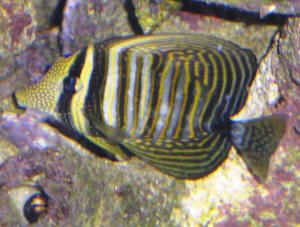
|
|
Re: Desjardinii Sailfin Tang with Possible Ailment
6/4/2011
Bob,
<Hi John>
Noted, and thank you so much for donating your time to help me
and this hobby.
<Indeed a pleasure and honour to share John. Cheers,
BobF>
John
|
Hole In the Head Disease... Read-over
11/5/10
Dear Crew at Wet Web Media,
I have a Desjardin Sailfin tang and I was just recently told that he
has the "Hole In the Head Disease".
<Quite common in this genus of tangs in captivity>
I have been reading a long string of corresponded on the internet about
how to treat this disease.
I have been seeing two different names "Iodine & Iodide"
What is the brand name for either of those products so I will know what
to ask for at the fish store.?????
<Mmm, actually neither... Iodide-ate are forms/valences of the
element Iodine that are of use, indeed are a micro-nutrient of much
life on this planet, but the erosive condition HLLE is not caused by
its lack...>
Also need to know the name brand for the Zoe as well "Formula II
soaked in Zoe"...??????
<See the Net for Zoe, or Zoecon... this is a product name, a capital
noun...>
What kind of Baby Vitamins are being used that I saw being mentioned as
well??????
<Any general mix/brand>
Is this liquid form or pill form crushed and mixed in with the food
that is being soaked???? Any particular brand????
<Liquid is best>
I feed him both Green, Purple, & Red seaweed made by Julian Sprung
until I ran out of the Red Seaweed which I have been having a really
hard time locating that particular item. I also soak them in Selcon but
I ran out which I could not tell but did not look like it was even
helping any.
Also feed chopped up shrimp, scallops bought from the fresh seafood
department at the grocery store along with squid (frozen) grinded up in
a food processor. His had been a very greedy eater but has recently
slowed down compared to how he use to eat. I have had him/her in a QT
(42hex) tank for about 4wks. The only improvement I have seen on his
body was that a very small line had appeared about where the Lateral
Line would be after treatment of Melafix & Pimafix that line is now
gone.
<... worse than worthless scam products>
In the main tank (55gal)
<This volume is too small for this species... by more than
half>
I am running the Eheim 2217, Penguin Bio-Wheel Filter 350 plus a Hydor
#2.
In the QT tank (42Hex) I am running a Aqueon Power Filter 55gal & a
Fluval filter system #4.
Water changes bi-weekly but now have changed to weekly. Now using
Tropic Marin Pro Reef Salt just started about 2-3 weeks ago.
<<Picture (Device Independent Bitmap)>>
Mary
<Please read here: http://wetwebmedia.com/stripedzebrasomas.htm
and the linked files above, and: http://wetwebmedia.com/mardisindex.htm
scroll down to Nutritional Diseases. Bob Fenner>
|
possible Lymphocystis with sailfin?
4/24/10
Hi Crew,
<Helen>
I've had a sailfin tang for over a year now, he has had
Whitespot before and he's currently got a single white spot
(quite larger id say than an 'ich' spot), I've just
noticed a second smaller one starting. they are in
exactly the same spot either side of the mouth, just above the
corners. The first one appeared about 2 weeks ago, started as a
spot slightly lighter in colour to the normal area of skin, then
gradually become a bright white and now is growing out and above
the level of the skin.
Is this Lymphocystis?
<May be viral>
it looks like the larger spot has become a bit like a cauliflower
but hard to tell at this stage.
He is eating as per normal, nothing else is out of place. I feed
Spirulina brine shrimp, mysis shrimp and Nori daily.
The tank is 285L
<Needs more room than this in time>
with corals and live rock, a six line wrasse and a few
Chromis.
I water change 20% every week, with 0 nitrates, nitrites and
ammonia. ph is 8.3, kH 8-9, calcium 400 and temperature sits
about 25C.
I figure I will wait and watch carefully, as I don't want to
unnecessarily remove him and cause undue stress.
<I agree>
Just thought perhaps I could get a possible diagnosis or steer in
the right direction if I'm thinking the wrong way!
2 Pictures are attached.
Kind Regards,
Helen Bidwell.
<I might try adding a purposeful biological cleaner... Perhaps
a Lysmata amboinensis... in the hopes it will excise this
material, lower stress. Bob Fenner>
|
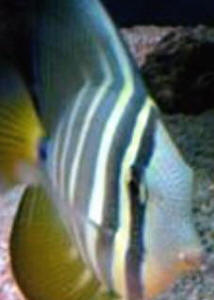 |
| Sick fish can't identify... "sent by
phone!" 2/16/08 |
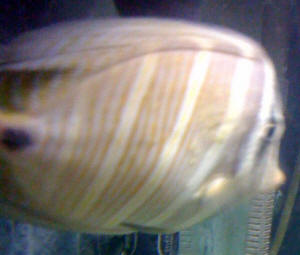 |
| Another picture this is my only means. Please
understand. <Say what? A Zebrasoma... with a
"bad" mouth, some sort of protozoan complaint...> |
| A third picture. Symptoms are clumps, whit spots, and
dark lines? Please help. I have been treating with an
formalin/malachite green product. Please help! ... no
reading, no data... <You're joking? In order to
help folks we need data... the system, history, water quality
tests... You're wasting y/our time here, and your
livestock's health. Please read here: http://wetwebmedia.com/sailfindisfaqs.htm
and the linked files above. Bob Fenner> |
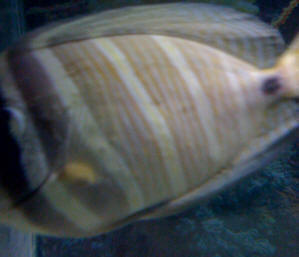 |
| Re: A third picture. Symptoms are clumps, whit spots,
and dark lines? Please help. I have been treating with an
formalin/malachite green product. Please help!
2/16/08 Bob, the readings are all within normal
parameters, <...> or I would have specified earlier, the
other fish are all doing good as well. This is an established tank
of more than a year. Temp. Is 74, salinity @ 2.0. <... what?
No.> Nitrates undetectable. Can you identify it from the
pictures? <... Please read where you were referred to.
B> |
Sailfin "Black Spot" only behind eyes?
12/22/08 Greetings crew, thank you in advance for your time
and wise, patient advice. <Welcome April> I have thought for the
past several weeks now that my Sailfin has Black Spot disease. He only
has those Black Spot looking pepper dots just behind his eyes, a small
cluster of them, about 7-10, all together, patterned like a half moon.
None anywhere else. <Mmm, something else> The rest of his body is
clear of any black dots. I have included a photo here of what my
guys' looks like. <No photo attached> (This is not my fish,
I've searched the web for an image to show you. I do not have
permission to use this photo publicly.) So, does this fish have Black
Spot? <Not if only behind the eyes, no> I see a little pitting on
this fish, like some sort of erosion, mine just has the few black dots
also seen here. So much research I have done on what this disease looks
like, and every source I have read discusses the dots over the entire
body, not just in one area as shown here. Are these handful of dots
cause for concern? Happy holidays! April. <The markings may be
symptomatic of HLLE... Please read here: http://wetwebmedia.com/HLLESWCauseF.htm
and the linked files above, and try to send along a well-resolved pic
if you can. Cheers, Bob Fenner>
| Question about a Desjardini tang sickness
-09/03/08 Hello. Hopefully the pictures come through fine.
<Yes> My question is in regards to my Desjardini tang. I hope
the pictures show the small brown spots he is developing. <I see
these> Two days ago I snapped some shots and looked at them and
his skin is perfectly clear. Tonight I looked and noticed he has
these light brown spots all over his body. Any idea what this is?
<Yes... "stress" markings...> Everyone else in the
tank seems fine. Grant <Mmm, something amiss... psycho- or
physiologically... See WWM re all Zebrasoma entries. Bob
Fenner> |
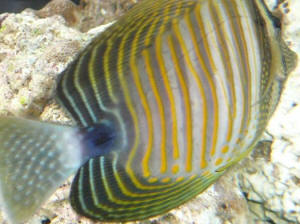 |
|
Re: Question about a Desjardini tang sickness
09/04/2008 I'm actually glad to hear it is
"just stress" because I was wracking my brain trying to
figure out how a disease could have been introduced. I've
been very careful about quarantining my fish for 4 weeks before
introduction to the main display tank, thankfully none of my fish
have ever shown any indication of illness so I actually
haven't had to treat anything. <Good> After I fired off
my email last night, I did my basic water checks and sure enough,
one of my parameters was way out of whack. I had a little problem
this weekend that caused there to be no water flow in the main
tank and barely any through the sump for probably 4 or 5 hours. A
210 gallon tank doesn't cool much in 5 hours, but I'm
sure it dropped a degree or two and there was no flow, so low
oxygen levels. <This would do it> Also, I had a very
important meeting to go to Sunday morning (this all happened
Saturday night/Sunday morning) so I just really quickly bandaided
the problem so my system was up and working again and then went
to my meeting. Long story short, I had lost about 10 gallons of
water that Sunday morning and when I replaced it, I did it with
1.025 salinity saltwater. In my haste I didn't use my regular
freshwater for top off, I don't know what I was thinking, I
guess I just wasn't. Anyway, I checked my salinity last night
and it was 1.0275. I have since lowered it to 1.026 and tonight
I'll finish lowering it back to 1.025. Can salinity alone
cause these stress markings on a Zebrasoma? <Yes> I think
I've read every single Zebrasoma FAQ multiple times now. I
looked some more last night and didn't see anything about
this either, I even used the search function for "Zebrasoma
brown" just to see, there are a couple references to
Turbellid worms or else velvet (which I was really hoping this
wasn't) but nothing else. I guess here in a couple days
though there will be an entry in there for exactly what I'm
dealing with :) <I believe you're right...> The other
annoying thing is this... I have a small Purple tang, about
2.5". The Desjardini is about 4.5", they don't
fight at all that I've ever seen and I spend a great deal of
time watching my tank. After the Desjardini had the brown spots
last night, I looked closely at the Purple tang and I'm
almost sure he has ich. There aren't any spots on his fins
yet, but the fins are so yellow it would be really hard to see
unless the spots got big. He just has probably 10-15 small white
bumps on each side of his body. <This could be something
else... even "nothing"> I didn't see him
scratching and I didn't put him into QT because if he does
have ich, <I would not> then so does the whole tank and I
don't have the means/time to move all fish into QT for 6-8
weeks while the main tank fallows. What really irritates me is
not only that I have a fish with small amounts of ich, but also
that I even have ich in the first place. I've been religious
about FW dip /formalin for 5 minutes and then into QT for
at least a month for all fish. None of them have shown signs of
ich in the QT and I really examined them closely. I didn't
treat proactively for ich, I figured if after a month they
didn't show the tiniest dot, then they didn't have it.
And yet here we are, about 2 months after my last fish went into
the tank and yep, I've got ich. I've probably had it all
along and just the stress of the weekend brought it out.
<Patience here> Anyway, just irritating. I cant think of a
time when I swapped equipment between tanks (I have a dedicated
QT tank set and a display tank set) and I even FW dipped between
going from QT to display. All that trouble, literally months of
quarantine, mixing lots of salt water to do 20% water changes
daily on the QT tanks, special feeding and babying of the new
fish and I've still got ich. I wonder at what point I messed
up and introduced ich into the tank, although I've been
wracking my brain and I cant think of when I did it. One fish
must have just had a little ich on him in an unseeable spot,
probably the gills and just didn't show it, so I ended
up passing it into the display tank eventually. Thanks for
reading my rant and for all the good work you guys do! Grant
<Welcome. BobF>
Re: Question about a Desjardini tang sickness 9/6/08
9/8/08 Thought I might comment on this, too. Bob, since
you're probably painfully familiar with me, you may recall I
have this same situation in my tank. We have a
'subclinical' presence of Ick in my tank still, and your
recommendations for such a situation have worked well. Once every
few weeks I will see a few cysts on my fish, particularly the
Atlantic Blue Tang. A day later, they will be gone with no
reoccurrence for weeks. Our regimen is garlic supplemented with a
variety of foods and 'Vitality' by Seachem. If we add a
fish, we QT it for a few weeks, but mainly to build up it's
resistances and to make sure it is in full health before adding.
I wanted to comment because I know how frustrating it can be for
this guy, but there is hope. Thanks again, Thomas <Thank you
Tom. BobF>
|
Swimming Erratically First time writer to your column,
been reading it for a while. I have a 60 gallon tank with a number of
corals (elegance, bubble, colt, Shrooms, frogspawn, brains, leathers)
with four types of tangs (Naso, Yellow, Regal Blue, and Desjardini), a
Coral Beauty angel, and two black clownfish. Well, everyone is doing
great with the exception of the Desjardini tang. Lately, he has been
swimming erratically like his swim bladder is not functioning. He flaps
his fins like crazy to keep his body from floating sideways to the top.
Or, he swims at a straight down angle or in a looping fashion. His
appearance and appetite are normal. Is this a documented condition and
is there any thing that can be done to lessen the stress??
<<How long you had that Zebrasoma? Ever been treated
by/with copper? Sometimes Sailfins just go this route... and no, not
much/anything you can do (that I'm aware of). Bob
Fenner>>
Holes in Dorsal Fin I've got a 6" Sailfin tang
in my display tank (125gal.) and he's been doing fine for the past
1 1/2 yrs. But recently (2-3 months) I've noticed that his large
dorsal fin has holes in it. From the looks of it, it seems to be
thinning. Any explanation or prevention of this? Also, I've got a
3" Kole tang in the hospital tank. The tank has about 2 ppm Cu2+
to control the nasties. The tang has been in the tank for almost two
weeks and last week I noticed what appears to be a blister or abscess
under his left pectoral fin. And in the last two days, it looks as if a
second is forming on his right side near the base of the dorsal fin.
Both have a somewhat circular shape so I don't think its lateral
line erosion. I'm not sure if he's just scratched himself
against a rock and the copper is affecting it or whether it's
something else. Any ideas or suggestions? I was planning on introducing
him into the display tank this weekend but now I might hold off.
<<Hey Bri. Re: the first surgeon... very likely the
"holiness" of the dorsal is a combination of mere growth/age
and a less than satisfactory diet. Do you offer 'human-food'
algae like Nori occasionally? Do so and dip it first in a vitamin and
iodine solution. The Ctenochaetus tang (Kole) is definitely in trouble
from the copper. Do remove the Cu++ or better still, move the fish.
I'd take the big risk and plunk it into my best reef tank. I've
stated such before, but this family and their close relatives (e.g. the
Rabbitfishes, Siganidae, scats: Scatophagidae, Idols: Zanclidae)
can't take much in the way of sustained, let's make that
chronic (more than a few days) copper treatments... kills off needed
alimentary microbes. Bob Fenner>>
Sick RedSea Sailfin Quit Eating Hello again Mr. Fenner,
I wrote you recently about copepods & 2-fish in my quarantine tank-
(flame angel & red sea Sailfin tang). My red sea tang has suddenly
taken a turn for the worse & has quit eating, breathing rapidly
& "hovering" in the same lower left corner of the tank
all of the time. My nitrates were at 20 & ammonia was very low but
my ph lowered to 7.9, from 8.3. So I added a small amount of Kent 8.3
to the tank. <Over what period of time? A change of no more
than 0.1 of a pH point in twenty four hours is about maximum> This
behavior started later that evening (Sunday). Yesterday I did a 3 gal
water change and nothing has changed. Any suggestions??? <Hope...
increase aeration... I would likely take the chance and move this
specimen to your main tank> Today is the 29th day in quarantine.
<This is too long... in almost all cases two weeks will get you
about all you can hope to get... unless the specimens that are being
quarantined show definite "catching" characteristics I would
limit this protocol to fourteen days> I would also like your advice
in another one of your favorite arenas. We are trying to plan a
vacation to a spot where we can observe salt fish collection, diving
(snorkeling) and seeing tropical fish and reefs first hand. Wives would
be along also, so a nice hotel is a must. I live in Las Vegas, NV &
my brother lives in Newport beach, ca. Naturally, the closer, the
better. We will be traveling in late Sept. or Oct.. Mexico, Belize,
Florida ??? <All good choices... and would toss in
Hawai'i... generally there are calm-enough places, warm-enough
water that time of year for HI... Take a long look on the Net at all
possibilities, and chat these up with all parties... When you narrow
the locale down we'll chat. Bob Fenner> Thanx for your advice in
advance. Craig
Re: Sick RedSea Sailfin Mr. Fenner, Thanx again for you
light speed response! The reason the 2 fish are in the 10 quarantine
tank is I've let the main tank go 30 days without occupants to
hopefully get rid of the crypto eggs. <Ah, now that makes
sense...> I hope I was doing the right thing. My LFS suggested to go
the full 30 days. I do put your expertise above theirs, although the
girl has 15yrs. experience. <Best to consider alls opinions to
make up your own mind, course of action> Do you think I should wait
the one more day, or get both of the fish back in the 50 gal. <If
the one fish looks as bad as you describe, I would move it. It may
perish otherwise. Bob Fenner> Thanx so much. Craig
Re: Sick RedSea Sailfin Mr. Fenner, It looks like I owe
you a Sushi dinner when you visit Las Vegas. I did find a great
"all you can eat in an hour" spot nearby. <I'm on my
way!> I added a Rio powered to my 10g to aerate the qt tank &
within an hour or two, the RedSea Sailfin was moving about the tank.
Although he still looks to be breathing rapidly, I think I will wait
the extra day & introduce him into my main tank tomorrow. He still
is not eating (I put Nori in the tank) but he does look a little
better. <The added aeration likely did the trick... the
Surgeonfishes need high, consistent dissolved oxygen> Since I'm
not a gambling' man, you can't if you live in this town, I will
wait till the morning. I would hate to go thru the crypto nightmare
again. I'll keep you informed. <Ah, good> Thanx so much for
your help. Craig p.s. I checked out a couple of spots in Belize &
will search more when I have more time. We'll chat when I narrow it
down. Thanx <Real good... if it's your first time, maybe just
Ambergris, San Pedro, about the Hol Chan... if you and wives are more
adventurous, Caye/Key Caulker, Tenerife, many other off shore island
possibilities... Lots of time, wanderlust? Drive the length down to
Placentia, out to Laughing Bird.... We'll be chatting. Bob
Fenner>
Sailfin Tang, Help A.S.A.P **911** Hi Bob, Love your
Website! <Thank you... what would you do different, add to the WWM
site?> I need your expert advice in order to prevent my Sailfin Tang
from perishing. This is the second time that I am asking for your help
with this same fish. The first time you were great and right on the
money with your advice and I hope you can do the same this time around.
I have been watching him very carefully each day, and he still exhibits
signs of parasitic infestation. His appetite is still very good and he
has a slight case of HLLE, but the main concern is that he is still
breathing very rapidly, which makes me believe that he has gill
parasites. With the mis-fortune of not having my hospital tank up and
running I have come the conclusion that I have only two options. The
first option now is treat my main tank with CopperSafe and pray that it
will take control of this parasite, or my second option is to take this
Sailfin Tang out of the main tank and try a" freshwater dip".
<The latter would be/is my choice for now... with a dilute
formalin/malachite dip solution... look for the Kordon Corp. product
here. And also Zoecon to add to the tank, food to help you with the
HLLE... and live macro-algae as detailed on the WWM site> My only
concern is the procedure in which this method is done. Please Bob, give
me some advice. I would greatly appreciate it if you could give me the
correct step by step instructions on this process. For instance:
correct water conditions such as temp, ph, length of time the fish
should be dipped, and also what to do after the fish is dipped. Please
reply A.S.A.P if you would be so kind!!!!! <These are spelled out
well enough on the dip/bath section in the marine index. Please read
them, download there. Bob Fenner>
Saltwater (Sailfin Tang) Disease Hi, Mr. Fenner I just
had a few questions about why the tangs are so hard to keep healthy
looking. My Sailfin Tang always seems to be breathing heavy and his
lateral line also seems to be a little faded. What is the cause of all
this? I give my fish a variety of foods like: brine shrimp, algae
cubes, bloodworms, clam cubes, flake food, algae strips from seaweed
select and I also add Vita-Chem to their food daily. I tested all the
levels in the fish only aquarium and they all fall within the
parameters. My tank size is 42gal.Hex. and I also have a Niger Trigger
and a Snowflake EEL. If you will please E-mail me back ASAP with some
advice. Thanks, Tom <Thank you for caring enough to investigate...
These are not good signs as you know, but you may well have provided
all the information here that is necessary to solve your systems
problem. Yes, this is likely what can be termed an "environmental
disease". That is the cause of the poor health manifestations
listed (heavy breathing, HLLE) are due directly to unsatisfactory
conditions in the living quarters. Please do read over the FAQ section
associated with the term "environmental disease" posted on
the site: www.wetwebmedia.com and consider the following: Increasing
aeration/circulation (airstones, powerheads...) as of the fishes you
list, the Tang is the one with the highest dissolved oxygen need. And
to discount the likelihood that this may as well be a nutritional
deficiency syndrome, do add liquid vitamins, and iodide (often called
iodine in the trade) supplement to the fish's favored foods ahead
of placing them in this system... Additionally, I would add some live
rock to this system, some macro-algae to improve water quality and
offer as food on a constant basis... and start saving for a larger
system, as these fishes will need such within a year. Bob
Fenner>
Sailfin Tang I have a 55 gallon tank with a
Sailfin Tang, Naso, Yellow Tang, Foxface, and a Percula Clown. I keep
my SG around 1.022. My PH runs around 8.2, Ammonia 0, nitrites 0,
nitrates around 5ppm,temp at 77, and calcium at 400. I add Lugol's
iodine once a week, Strontium 2x week, There is about 35 pounds of live
rock with various mushrooms growing, and a couple of feather dusters
that have came out over the last few days. I vary there diet with
frozen brine shrimp plus, flake foods, organic grown romaine lettuce,
and SERA Tablets ( the stick on the glass ones.) Now that's the
specifics on the tank and its inhabitants now on to the questions. My
Sailfin has appeared to change colors. From black and yellowish stripes
to an almost beige or tan color where they used to be black. Is this
normal? Also this morning I saw him rubbing his head on the substrate
(which by the way is aragonite) and I am wondering the best course of
action. i.e. fresh water dip, medicated flakes etc. I know you gonna
ream me out for this, but I don't have a quarantine tank setup to
isolate the Sailfin. But all be it I'll have one soon...Also any
other suggestions would be appreciated. Thanks, Brian... <<Hmmm,
not so fast... the color changes you mention and the
"scratching" behavior may well not be indicative of a
parasitic or other diseased condition... They may be
"natural"... I'd hold off on dipping, any other chemical
manipulation till you actually see some physical manifestation on the
fish itself. One thing I would do that will help, and has little
potential downside is add a cleaner shrimp... one of the species of the
genus Lysmata. Bob Fenner>>
|
Desjardinii Sailfin Tang Question, no useful data
8/20/07 Hi, I have a Desjardinii Sailfin Tang which seems to
be losing it color. It is happening in the same place on both
sides. See attached photo with arrow. Do you have any idea what
this is? The water chemistry, diet, lighting has not changed. The
fish is eating well. Thank you for your help! Laura Lee <...
Please read here: http://www.wetwebmedia.com/fishindex3.htm the
second tray down... BobF>
Re: Desjardinii Sailfin Tang
Question 8/26/07 Hi Bob, I am sorry... I have
gone to the link and the "second tray down", but I can
not for the life of me find what it is my tang has. I have gone
through the links for the past two hours. Do you think you could
be a little bit more specific? I must be missing something. Thank
you so much for your time. Laura Lee <Could be a few possible
"things"... a simple mechanical injury, some sort of
result from treatment... Stress marking... Am/was hoping that by
reading, perusing you would be able to provide more/better input,
realize yourself... BobF>
|
|
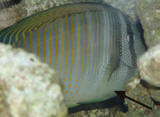
|
| Sailfin specks 6/13/07 Dear Crew
Members, <Fred> The accompanying photos show a Sailfin tang
on whom dark marks suddenly appeared three days ago. The tiny
splotches were accompanied by a very light ("faded")
color instead of the usual, high-contrast Sailfin markings, and
occasional, though not persistent, scratching. Appetite and general
behavior did not seem very affected. Three slightly smaller yellow
tangs in the same 220 gallon tank have not shown any similar
symptoms. <These would very strikingly show such if this
flatworm were present> Naturally, I consulted your excellent
site, and although the symptoms did not seem a perfect match to
Paravortex, that seemed the most likely diagnosis. I caught the
fish (we frequently feed from a net, to enable fast fish removal),
<Thank goodness!> did a 9-minute fresh water dip, and put the
fish into quarantine. Over a day later, his overall coloration has
returned to normal, but the specks are still present (though
possibly less contrasting). <I see these> Now I am wondering
whether I may have misdiagnosed his condition. The Sailfin is just
over 3 years old, and had always lived by himself until about 9
days ago when we consolidated fish from our smaller tanks into the
larger tank mentioned above. The sailfin was the first fish in,
joined after a few days by three Yellow Tangs who have lived
together for a few years, a Clarkii Clown, a recently acquired Kole
Tang just out of quarantine, and a school of 8 small Chromis
cyanea. We have been very pleased with the lack of aggression,
especially among the Zebrasomas. To your experienced eyes, do the
specks on the Sailfin appear to be Paravortex? <No> If so,
should I perform another dip or two at 3-day intervals? If not,
what would be your alternative diagnosis, and should I keep the
fish in quarantine? <I do think these are "just
markings"... There is some evidence of pitting... perhaps
linked to neuromast destruction (HLLE) over time... but not likely
a problem, issue.> Thanks for your long-term dedication to our
hobby, and of course for your help, Fred <I would likely do what
is easiest here to improve water quality (add activities, gear,
clean up... to increase RedOx...) and augment diets... with
addition, soaking of foods with a vitamin, Iodide/ate, and HUFA
prep.. Bob Fenner> |
|
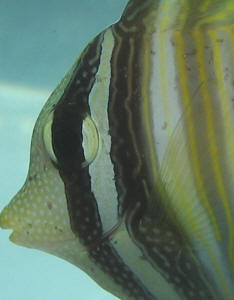 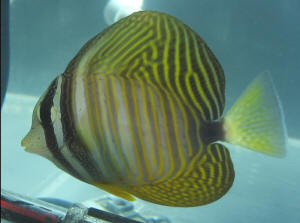
|
Sailfin Tang - dying? 5/30/07 Hello -- Appreciate
your informative site!! We have a 125 gallon reef tank, 1 Red Sea
Sailfin Tang about a year old, 1 Red Flame Hawkfish, 1 Coral Banded
Shrimp, 1 long tentacle anemone (New) and some various polyps and
mushrooms. Param.s are as follows: PH 8.3 Amm = 0 Nitrites = 0 Nitrates
= 0 Temp = 83 (bit high I think, but just put new MH Lights in) In the
last couple days my Tang has been acting a little strange, hanging out
in one of the corners and not really swimming around like normal. We
moved the powerheads around a bit but that didn't help. <May be
just simple low dissolved oxygen, elevated temperature at play
here...> When I woke up this morning, I thought he was dead. He was
hanging' upside behind one of the rocks. I went to net him out and
he swam, head down and upside down back over to the anemone. I left him
alone and came back to check on him and he was resting on the anemone.
I nudged him to see if he was alive and he got caught up in the
current' - trying to right himself as he was upside down and/or
sideways. Also, one of his eyes are cloudy. He is typically a very
social fish! We did a water change last week and rearranged some of the
rocks, added the anemone. <This may be a source of morbidity,
mortality as well> We had our old VHO ballast blow last weekend, so
there was a day and half with out lights and then we moved to a MH
light system. This is a well established tank and everything else seems
to be doing just fine! Any ideas, suggestions!? Thanks in advance!!!
Jessica <Please read here:
http://www.wetwebmedia.com/fishindex3.htm
Scroll down to the tray on Tangs, particularly the articles, FAQs files
on the genus Zebrasoma. Bob Fenner>
Re: Sailfin Tang -
dying? 5/31/07 Well he has now died. Now, I am very curious
about what could of killed him! Is it possible he could of been stung
bad enough by the anemone? <Yes> As he was dying, his skin was
turning white -- is that a sign of something or just the dying process?
<Could be either, both> At any rate -- any insight would be very
much appreciated! BTW -- the registration for the forums is not
working. <Have sent this over and over to the administrator...
Lorenzo Gonzalez... Don't know what the issue is, nor can I/we fix
it for him. Thank you> Thank you- Jessica
Desjardini Tang with
pockmarks 5/23/07 Dear Sir: <John> I reviewed
your FAQs but my situation seems to be different than HLLE, etc. My 3
year old Desjardini Tang has these white "divots" confined to
the area around its eyes above and below. The eyes are clear and the
fish is active, colors otherwise vibrant, is an eager eater and appears
healthy. These divots have existed for approximately
1.5 years and may be getting slightly worse. <Mmm, this
is almost certainly a form of "Neuromast destruction"... IS
HLLE...> The diet is primarily Formula 2 and Nori and whatever meat
it can steal (and it doesn't get much) from the trigger, lionfish,
2 wrasses and a moray eel that live with it in a 125 gallon tank
(FOWLR). <This is way too much fish life for such a volume> I
have about 40 ppm nitrates <And twice as much nitrate as they should
be exposed to> with 0 nitrites and ammonia. I buffer pH to a
constant 8.3. <Good> In case you think it related to my problem,
because of all of the messy eaters I have in the tank, I religiously
change approx. 20 - 30 % of water per week. <You need more space
period, and likely more/better filtration> Do you have a theory as
to what may be causing this problem with my tang and what do you
recommend I do about it ? <Poor environment and
nutrition... Improving them/these...> Thanks for your help. John
<Posted... over and over... Please read here: http://www.wetwebmedia.com/hllefaqs.htm
and the linked FAQs files above... Bob Fenner>
| Sailfin Tang markings 4/6/07 Hello
gang, I've been visiting the site for a while now, but this if
the first time I've written in. Let me jump right to it.
I've had my sailfin tang for about a year now. He is
approximately 4". He eats anything and is very active, but
over the last few weeks he has started to get some unusual spots on
him, and I can't'¬"¢t figure out exactly
what it is. I'm hoping that one of you will be able to identify
the problem for me. I've asked him nicely to stay still for a
picture, but to he just doesn't seem to want to cooperate. I
was able to get one decent shot, I circled the new marks, as you
can see, there are quite a few. I feed him a variety of frozen
foods, Nori, flakes, Spirulina, and once a week or so, I soak the
Nori or frozen food with Selcon. <Good> His current home is a
125G tank with about 150lbs of live rock. I'm running two
Aquaclear 500 filters, an Odyssea CFS4 canister filter, an AquaC
Remora pro skimmer, a Seio 1500 powerhead, and another smaller
powerhead (don't know what it is). Water parameters are:
Ammonia - 0; Nitrite - 0; Nitrate - 10; PH ' 8.4; Alk 4.0 mEq/L
(200ppm); SG 1.022; Temp at 78 degrees. The other tank mates are:
3" regal tang, a tomato clown, a fire fish, and some assorted
hermit crabs and snails. Everyone else seems normal. Any help or
suggestions you can offer would be greatly appreciated.
- Khris <... these are very likely "just" stress
markings... Likely the Tomato Clown and Regal tang are taking turns
challenging this specimen... How deleterious is their
territoriality? This Sailfin might be moved to another setting...
does eventually get much larger... And I'd like to mention the
benefits of using Spectrum pelleted foods with these fishes... good
nutritionally, and seems to reduce inter-species competition. Bob
Fenner> |
|
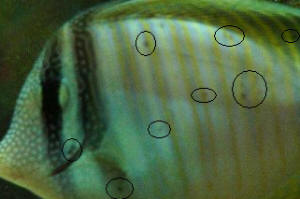
|
|
Sail Fin Tang... HLLE and Trematodes... -11/27/2007 I have
a Sail fin tang. He has small holes all over his body and fins.
<I see these in your photo> I thought it was Ick but have
not had any luck treating for Ick. <Are likely flukes... and
neuromast destruction...> The best way to describe is the
holes with something white in the middle of them. Something seems
to be eating away at the skin. I have attached a very large photo
so you can zoom in. Any help would be appreciated! Thanks, Brian
Safian <... I would treat... successively... with
Metronidazole... then Praziquantel... see WWM re the use of these
compounds... AND you need to address your water quality and
nutrition... Something is amiss here that has allowed the HLLE to
advance... see WWM re HLLE causes/cures... Write back with
specific issues... Bob Fenner>
Re: Sail Fin Tang... hlth. f'
11/27/2007 Bob, <Brian> I have been putting
Metronidazole in food regularly for about a month <This is
MUCH too long for exposure to this material> and I treated the
tank with PraziPro. <This... should have "done
it"> Some folks have suggested I do the formalin dip as
that is also effective against Flukes and Ich and maybe feed
Metronidazole while the fish are in QT after formalin dip.
Basically, setup QT tank, do Formalin dips and then put fish into
QT tank for a while. My next question is, "Does the eel need
treatment." <...? What eel?> I know most flukes and
worms can be fairly species specific and this one might only go
after tangs. <Likely so> I just do not know what the
resistance to flukes is by different fish or eels. <Many
species are almost commensals...> I know that in tank
treatment is not recommended by most, but having a fish only tank
might be able to get away with dosing Praziquantel in the tank?
<Is done... frequently. Often times with success... though the
issue of co-interactions is pertinent... may absorb the
medicant/s> If it is not recommended, what the life cycle of
the fluke is and that way you know how long your QT has to be
for. <What?> Thanks, Brian Safian <See WWM, the Net re
Trematode diseases of fishes... BobF>
Re: Sail Fin Tang... hlth. 11/29/07
OK....Let me clarify. The Sail Fin Tang is in a FO tank with a
Naso tang and a Snowflake Eel. The Naso and Eel have no signs
parasites what so ever. Last night I gave the Sail Fin a 45
Minute Formalin bath. <... depending on
strength/concentration, this is too long for formalin
exposure> It seems today that several, but not all the holes
are empty so it may have gotten some of the flukes off. Everyone
seems to think I should bring the tank into Hypo, which I may
begin stepping down today. Sorry for the confusion Brian <...
please, don't write; read instead... on WWM re
hyposalinity... RMF>
|
|
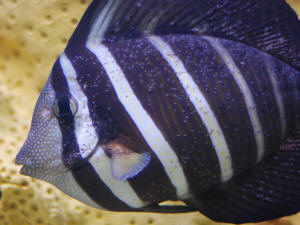
|
Re: Sail Fin Tang... hlth., blitzkrieg not
working, need ID 12/20/07 Bob, <Brian> I wanted
to get your opinion on a Fish Illness I had discussed with
you a couple of weeks ago. I wanted to give you update and
new photos to rack your brain a little if you don't
mind. The Sail Fin Tang is in a tank with a Naso Tang,
Snowflake Eel. Neither of them have any signs of parasites.
I have included the latest photos to compare with previous
photos. Below is the plan of action I currently have taken.
1.Treated with PraziPro (<5% Praziquantel) treated once
(No effect) 2. Treaded with ParaGuard 3. Tried a Formalin
Dip of 200 ppm for 45 min (no long term effect) 4. Feeding
with Metronidazole every other day (No long term effects
slight decrease in red color in wounds) 5. At Hypo (SG
1.010) for past 5 day Slowly dropped hypo for 10 days
(Worms might be dislodging from wounds to surface but hard
to tell) 6. NO3 is a bit high at 25-50ppm but fish only
tank (Treatment might be effecting the bacteria cycle a
bit) 7. Ammonia is 0 8. NO2 is clear 9. Temp is at 77 10
The HLLE seems to be cleared up for the most part. <I
see> Fish is still eating but not swimming too active.
Only treatment left to try is maybe try Heart guard but
unsure about the effects. Your expertise would be
appreciated. Thanks, Brian Safian <On the basis of your
lack of results, am given to consider that the
"dots" may be something else... Perhaps a
micro/Sporidean, other subcutaneous protozoan. Again, is
there someway you can get/use a microscope with computer
adaptability or take this fish, skin/sample to a lab that
can take a look/see? BobF>
|
|
.JPG)
|
|
Re: Tank temp spikes and affect on Sailfin
Tang 6/1/08 Thanks for your help. Unfortunately, he didn't
make it. I fear that he had some sort of tissue necrosis, as large
chunks of tissue were just falling off on the head as well in the body,
just beyond the skull. <Bizarre... more than one thing going on
here> It got so bad that it seemed like I could see a portion of his
skull. I will send some photos of the condition. All other fish are
doing great. Out of curiosity, what size tank would you recommend for a
fish like my tang? <A Zebrasoma desjardinii needs at least a couple
of hundred gallons to "do well"... this species (distinct
from Z. veliferum further in the west Indo-Pacific out to Hawaii) gets
very large. Both to about a "standard length" (a fisheries
measure... sans basically the tail/caudal fin... of 40 cm... Yes, 16
inches... small individuals can "live" for a few years in
smaller volumes... but... not well in a longer term sense> I may or
may not seek a replacement (of any kind) if it will get too crowded
with my current livestock. <Do see fishbase.org re as well:
http://fishbase.org/NomenClature/ScientificNameSearchList.php?crit1_fieldname=SYNONYMS.
SynGenus&crit1_fieldtype=CHAR&crit1_operator=EQUAL&crit1_
value=zebrasoma&crit2_fieldname=SYNONYMS.SynSpecies&crit2_fieldtype=CHAR&crit2_
operator=contains&crit2_value=&group=summary&backstep=-2
Bob Fenner>
Re: Tank temp spikes and affect on Sailfin Tang
-- 06/02/08 Thanks, Doc. I appreciate it and will likely go without
a replacement to give the other guys room in my tank. <Real good.
BobF>
|
Mystery Spot On Sailfin Tang 3/24/08 Dear Crew,
<Andy> This morning I noticed a very strange, perfectly
round spot on my Sailfin Tang. See attached. This spot is
something very recent. Because of its symmetry, I don't think
it's an injury. Because it wasn't there yesterday, I
don't think it's some natural color morph. It almost
looks like a mole. I searched for about an hour on the net
looking for a picture of something similar, but found no needle
in the haystack. Any thoughts on what it might be? <Mmm, never
saw anything quite like that before. Your tang appears to be a
very healthy specimen and I'd just keep a close eye on that
spot, see if it develops into anything, or go away as quick as it
came.> Thanks! <You're welcome and keep us posted.
James (Salty Dog)> Andy
Re: Mystery Spot On Sailfin Tang 3/25/08 Thanks James!
<You're welcome.> I will keep an eye on it. It is a
very strange mark. I noticed that it seems to change in
brightness along with the changes that naturally occur in the
scales of the fish periodically (you know how the coloration of
tangs can fade and brighten in an instant and at night). <Oh
yes.> The tang is very active and seems very bright and
healthy--great eater, nice full body, happy and peaceful. He has
only 4 other fish mates--all smaller fish (Royal Gramma, Copper
Band Butterfly, Gold Stripe Maroon Clown and Brown Sailfin
Blenny). I feed him New Life Spectrum pellets, <An excellent
choice here. I use exclusively, rarely feed other foods. Have you
been to their website? Very informative. www.nlpublish.com>
live black worms soaked in Selcon, OSI Spirulina flake, sheets of
Nori, and Piscine Energetics frozen Mysis soaked in Selcon, so
I'm pretty sure he is getting a healthy, varied diet. I do
have some tree corals, a few LPS corals and some Corallimorphs,
but I don't see those as posing a stinging or other hazard to
this fish that would have caused this spot. Thanks again for your
time. Andy
|
|

|
Re: Corals, Stocking, Bought the Tang -
6/11/08 Hi again! <Hello Allison> I bought a desjardinii tang
today and thought it looked decent to me. <mm.. fish needs a bigger
tank.> However, I posted a few pictures up at
http://www.saltwaterfish.com/vb/showthread.php?t=323673 and a few users
disagree with me. Apparently, my tang has HLLE!...Do you agree? <The
beginning. This is an emaciated fish.> What should I do to help him
recover? <Return him to the store, and research before making your
next purchase. I don't intend to be a damper on your excitement for
the hobby, but your fish will be healthier and enjoy greater longevity-
and you will enjoy the hobby more- if you read up on disease, stocking,
etc and choose fish that are of an appropriate size for your tank and
which you know how to take care of.> Thanks! <Welcome. Best of
luck.> Allison
<Benjamin>
Surgeonfishes: Tangs for Marine Aquariums
Diversity, Selection & Care
New eBook on Amazon: Available here
New Print Book on Create Space: Available
here
by Robert (Bob) Fenner |
 |
|
|

